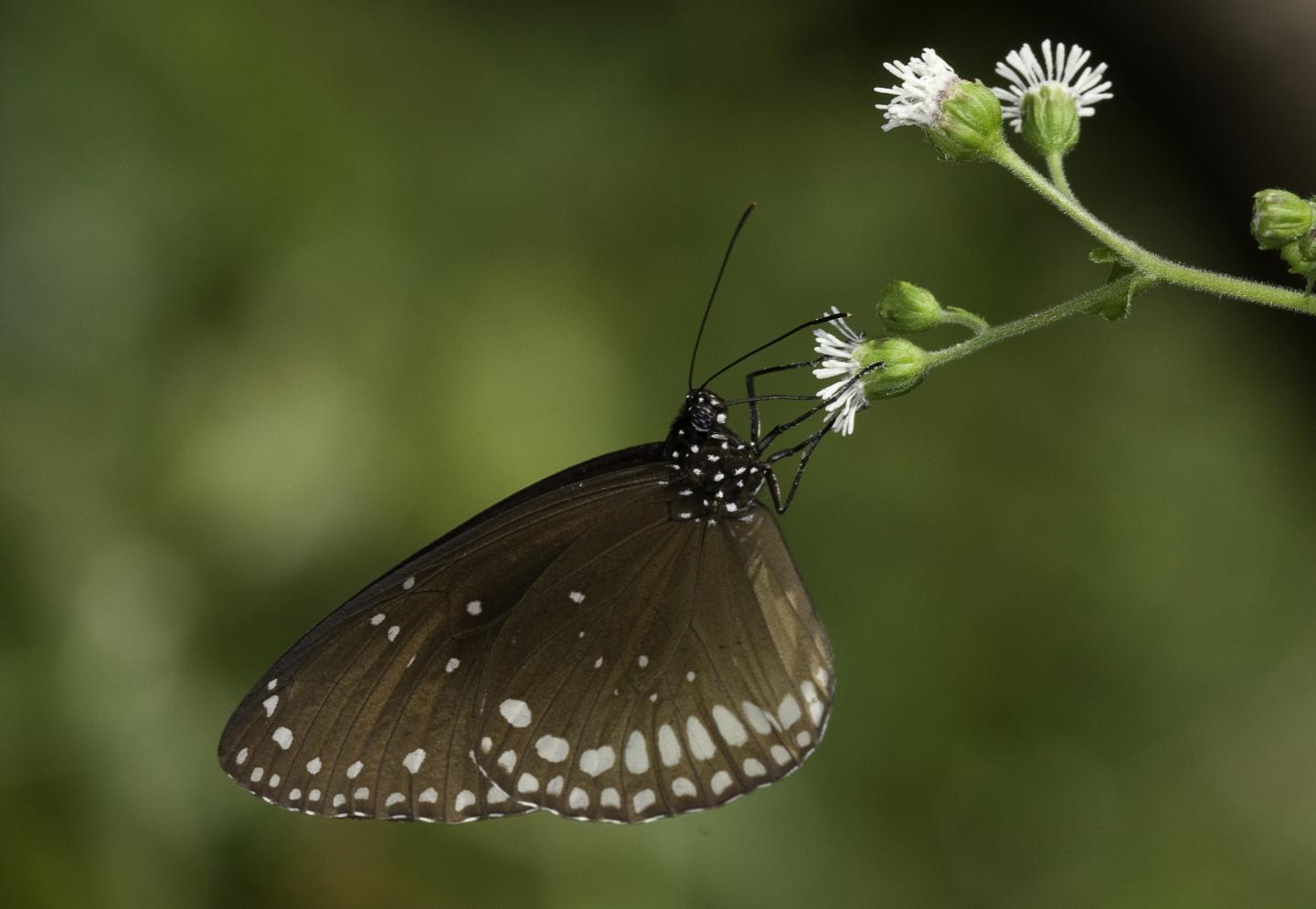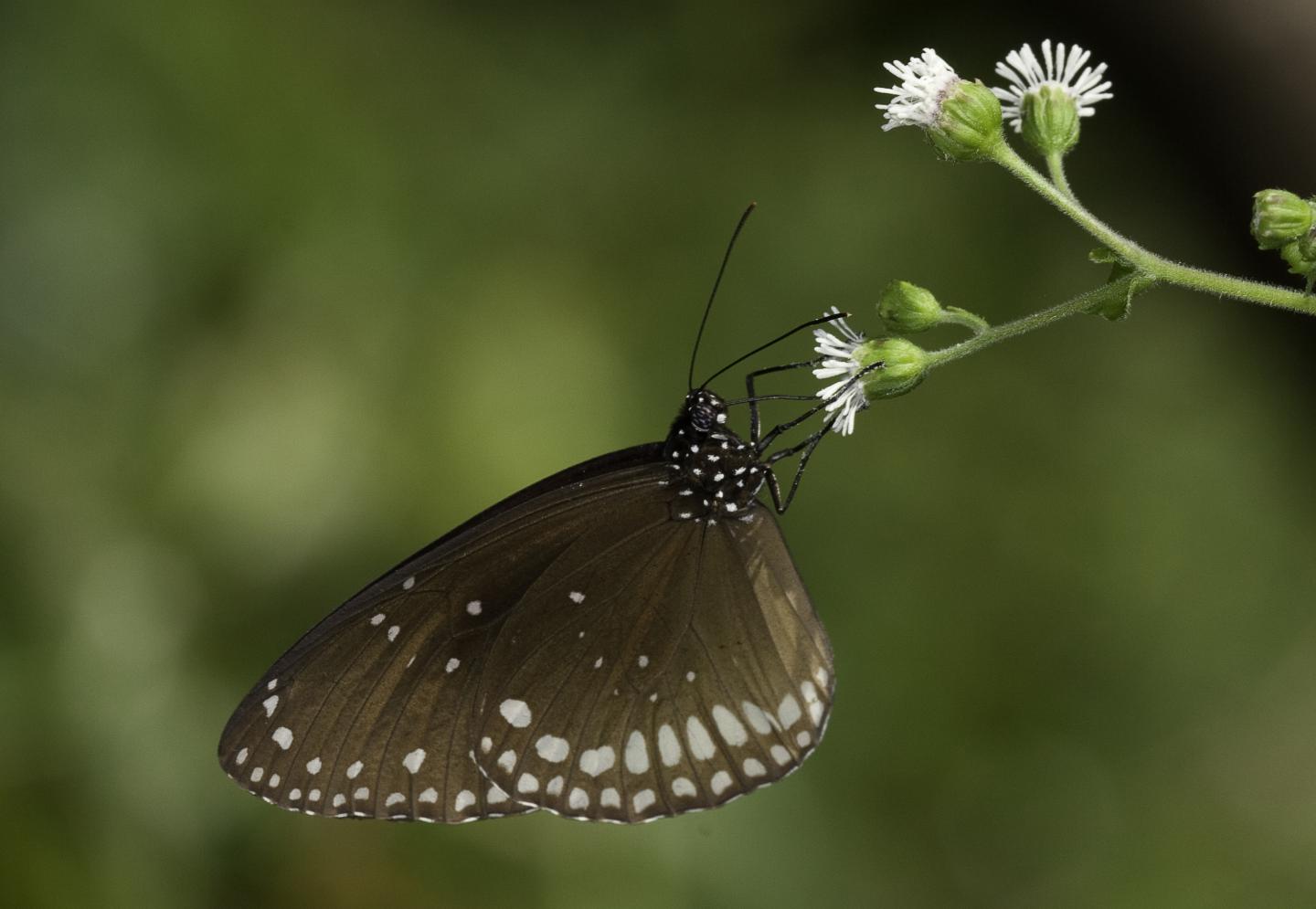
Credit: Dr. Krushnamegh Kunte, NCBS-TIFR
What do CPUs, stockbrokers, and butterflies have in common? They are good at investing their resources in the right place at the right time so as to maximize their returns! Trade-offs are a way of life for butterflies and other small insects that must budget their energy between numerous morphological features and activities during their short lifespans. Time, food, and space are always at a premium, and optimizing resource use is particularly important for migratory butterflies that must prepare for arduous journeys in uncertain environments. A new study by researchers at the National Centre for Biological Sciences (NCBS-TIFR, Bangalore) reports on butterfly migrations in peninsular India and explores the effect of migration on resource investment strategies of migratory butterflies. It reveals that migration affects the morphology and physiological states of female butterflies much more prominently compared to that of males.
Milkweed butterflies (so called because they feed on plants with a milky sap) are commonly found in gardens and wooded areas in southern India. Every year, four species – the Double-branded Crow (Euploea sylvester), Common Crow (Euploea core), Dark Blue Tiger (Tirumala septentrionis), and Blue Tiger (Tirumala limniace) – undertake a bidirectional migration between the Western Ghats and the southern Eastern Ghats and surrounding eastern plains. Swarms composed of millions of these butterflies grace the environs of Bangalore on their way. This spectacular phenomenon first occurs between April and June, before the southwestern summer monsoons hit the Western Ghats, when butterflies are driven by pre-monsoon showers to the eastern plains and hills. The return migration to the Western Ghats, undertaken by newly emerged butterflies of the next generation, takes place between October and December, after the south-west monsoons are over.
During the migration, these butterflies fly for long hours through unfamiliar landscapes and unpredictable environments, and still manage to remain in stable conditions that allow them to breed at the end of the migration. Migration allows these butterflies to escape the torrential monsoonal rains in the Western Ghats, but the physically exhausting and energetically demanding 350-500 kilometer journey also forces these insects to make some peculiar changes to their lifestyle. This must take some carefully balanced investments in flight morphology and reproductive tissue that allow them to switch their physiological states and deploy fat reserves when needed. How do they do this?
To find out, Ms. Vaishali Bhaumik, a PhD student at NCBS-TIFR and SASTRA University (Thanjavur) and her advisor Dr. Krushnamegh Kunte decided to study reproductive dynamics and physiological states of the migratory species in relation to their investments in flight and reproductive tissue. Typically, non-migratory butterflies start breeding within a few days after emerging from their pupae, with females growing bigger abdomens to accommodate eggs and fat tissue. Migrants, however, remain reproductively inactive during migration, i.e., in reproductive diapause. On comparing the abdomens of migrating butterflies in reproductive diapause with those of breeding individuals, Bhaumik found that being in a state of active reproduction has a disproportionately large effect on the body proportions of females. While the gonads of both sexes grow in size during the breeding season, the abdominal burden is significantly higher in females because of the sheer size and number of eggs they carry and the fat reserves required to sustain such an energetically costly reproductive effort.
"Our results indicate that female butterflies may have a lot more to lose if they do not invest optimally in flight over reproduction during migration. A hiker wouldn't carry around an unnecessarily heavy burden during her trek, and neither would a butterfly," said Bhaumik, adding, "Migrants live longer than their resident (non-migratory) and reproductive cousins. They have distinct physiological states in their lifespans to meet the unique demands of a gruelling migratory flight, followed by reproduction." The butterflies die soon after laying eggs, and this could mean that investing in reproduction speeds up their ageing process. This strategy of entering reproductive diapause during migration and then breeding at the new location after migration thus allows females to fly across peninsular India with a lighter abdomen, and to produce a large number of eggs when the migration is over.
A new generation of butterflies returns to the Western Ghats before the northeastern winter rains in November to January. However, this return migration is not frequently seen by butterfly watchers on the ground. This could be because there are fewer migrants in the returning swarms, they fly along different routes in a more loosely organized fashion, or fly at higher altitudes than those observed during the plains-ward journey in April-July.
Future work on this migration will concentrate on the climatic, behavioural, and genetic aspects, say the researchers. "We would like to find out exactly what environmental conditions drive the switch between migratory and reproductive bouts," said Kunte. "Our ongoing investigations into any possible genetic and hormonal differences between the migratory and non-migratory populations will go a long way in explaining this phenomenon."
###
Media Contact
Krushnamegh Kunte
[email protected]
91-802-366-6086
http://www.ncbs.res.in
Original Source
http://news.ncbs.res.in/research/breed-or-not-breed-migratory-female-butterflies-face-monsoonal-dilemma http://dx.doi.org/10.1111/oik.04593





